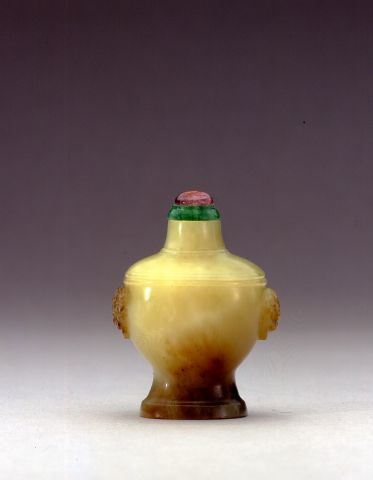
Bottle ID: 406
URN
Date: 1735-1799
Height: 44 mm
Nephrite, translucent yellow, of pebble material with traces of inner skin of a greenish-brown color; of well hollowed compressed apple shape, the sloping shoulders curving into a tapering cylindrical neck with a flat lip and with a deep, flaring base pedestal with a recessed flat oval foot rim with a raised flat outer footrim; carved to imitate a metal work vessel, with horizontal ribs at the base of the neck and the lower shoulders mantel, the narrow sides carved with mask and ring handles.
Imperial, Palace workshops, Beijing.
Similar Examples:
Crane Collection no. 641
Crane Collection nos. 161 and 259
Crane Collection no. 319
Moss, Hugh, Victor Graham and Ka Bo Tsang. A Treasury of Chinese Snuff Bottles - The Mary and George Bloch Collection, 1995, Vol. 1, pp. 256-257, no. 105.
Provenance:
Hugh Moss [HK] Ltd.
Beijing Hanhai Art Auction Corp., October 24, 1996, lot 166
Exhibited:
Annual Convention ICSBS New York, November 2013
This is clearly inspired by an ancient bronze form and although it is not, in its current form, specifically like any known vessel, it is probably based on a compressed zun with the wide, flaring mouth replaced by a more suitable narrow tapering neck for a bottle form. Another possibility, also taken from metalwork, is the ancient cooking vessel for preparing hot-pots where the fire is contained in the deep, flared foot, although as a rule when this form is copied it is specifically designated by leaving the opening in the foot where the fire is placed, so it is perhaps more likely to be derived from a transformed zun. Apart from the bronze form, among one of the many taken from metalwork and ceramic shapes which were so popular at Court during the first half of the Qing Dynasty, a Courtly and, more specifically, Palace workshops provenance are also endorsed by the choice of material, a favourite at the eighteenth century Court and used on so many Palace snuff bottles and other vessels, and on the type of mask handles which are typical of Court carving from the eighteenth century, with their small size, bulbous rounded heads, and small rings, creating in this case, an almost circular effect for the entire mask, including the rings.
This yellow material was extremely popular at Court, where a number of snuff bottles, objects and larger vessels were made for the Court, either at the Palace workshops or at Imperial facilities at Suzhou and elsewhere. It is characterized by this colour of greenish-yellow combined with a beige-brown colour, which may be inner skin on pebble material. Here it is very cleverly used for both mask handles to some extent, suggesting a quite small pebble if it is pebble material, and for the foot area. Formally, this is not only a unique shape for the Palace, but for anywhere else as well if one excepts the group of blue and white porcelain bottles imitating hot-pot burners with the pierced and hollowed out foot.
< Back to full list

 English
English 中文
中文